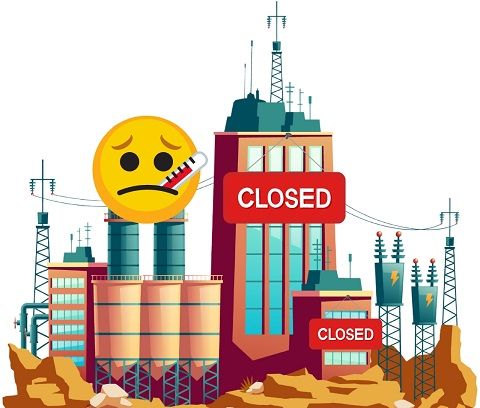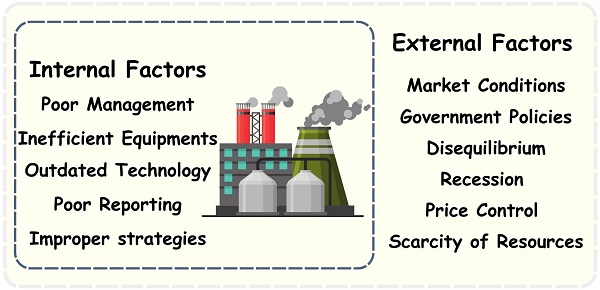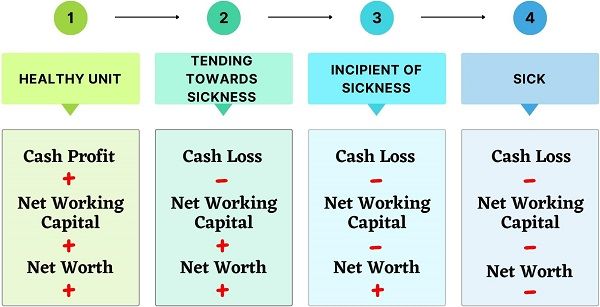Meaning: Industrial Sickness or Technical Insolvency is the consistent downfall of the industry’s financial position.
Simply put, a sick industry is one that is earning losses from a significant period. Moreover, it is expected to continue to suffer losses in the upcoming financial years.

Generally, sickness means not being healthy or fit.
An industrial unit’s health is defined by its Financial Position. It starts getting sick when it operates below the breakeven point. This is because, the units begin earning losses at any point below the breakeven point.
The accumulation of losses for a long time makes the unit sick. Consequently, the units suffer financial losses, unemployment and even insolvency.
The sickness severely affects the functioning of the unit. It is not just restricted to a single unit or industry. But it affects the economy as a whole.
An industry contains Small-scale, Medium-scale and Large-scale enterprises. Small-scale industries fall sick faster than large ones. This is because, it is difficult for them to revive and become fit again.
It is a universal problem as both developing and developed countries experience it. However, it severely affects developing countries. The reason is that industries contribute a lot to the developing country’s economy.
Sick industries show instability in the accounts and cash flow of the units. This results in a steady imbalance in various ratios like:
- Debt-Equity Ratio
- Current Ratio
- Net-worth to Outside Liabilities Ratio
With time it became an alarming problem which needs timely diagnosis and treatment. In the upcoming sections, we have discussed its symptoms, causes and remedies.
Content: Industrial Sickness
What is a Sick Unit?
It is the one which has accumulated losses in the preceding two or more financial years. Also, these losses exceed the total net worth of the unit. Moreover, such units will likely continue to bear future losses.
Due to illness, its internal resources are unable to support its operations. Ultimately, it becomes a threat to financial viability.
A precondition to being declared as a sick unit is to be a registered company for at least five years
Besides, a healthy unit is one which is capable of earning sufficient profits and payout liabilities.
Symptoms of Industrial Sickness
Units don’t fall ill overnight, but it happens gradually with time. During this while, sick units show some symptoms.
These symptoms help in diagnosing the sickness. You might have heard that diagnosis is vital, from spotting the disease to finding its cure.
Industries can keep a check on their financial well-being before they get gravely sick. They can monitor themselves based on the symptoms listed below:
- Imbalance in the unit’s financial position.
- Inappropriate utilization of resources.
- Imperfect goods production.
- Misuse of credit facilities.
- Untimely repayment of instalments and interests.
- Unbalanced cash and credit balances.
- Several outstanding bills.
- Frequent changes in the management across units.
Causes of Industrial Sickness
Industrial sickness profoundly affects the growth of the units. There are certain factors causing sickness. These factors are grouped under two major heads, i.e. Internal and External Factors.
Sickness is the outcome of the combined effect of all these factors.

- Internal Factors: These factors exist within the industrial unit and affect the specific unit only. This is why the management has control over these factors. It is related to the unit’s management or operations. It may arise due to the following:
- Poor Financial Management.
- Inefficient use of equipment.
- Outdated Technology.
- Poor Reporting.
- Improper Implementation of Strategies.
- External Factors: These factors exist outside the industrial unit. It affects the entire industrial group. Therefore, it is beyond the control of the units. It is related to the Economy, Global Markets, Government, etc. It may arise due to the following:
- Unexpected market conditions.
- Changes in government policies.
- Disequilibrium between the demand and supply.
- Recession in the economy.
- Government control on prices.
- Scarcity of Resources.
Consequences
The consequences of industrial sickness can be encountered in many sectors, including the banking sector. Some of the adverse effects of industrial sickness are as follows:
- It results in the complete shutdown of the industrial unit. Thereby, leading to unemployment and financial losses.
- The loss of production boosts the need for more products in the market.
- Less revenue to the Government due to the unit’s non-payment of duties and taxes.
- The financial institution and banks need to realize the loan amount issued to the unit.
- Loss to the shareholders and the creditors of the unit.
- Wastage of resources invested in sick units.
Remedies of Industrial Sickness
To overcome the problem of sickness, industries can adopt some rehabilitation policies. These policies are remedies that can cure the gravely sick units and those on the verge of getting sick.
The type of sickness may vary among units and industries. So, they need tailor-made solutions for each one of them.
In taking remedial actions, the Government, Financial Institutions and Banks play a vital role.
The Government can formulate policies and take the initiative to support the sick units. They must focus primarily on SMEs to protect them from getting sick.
Financial Institutions can prevent illness by careful selection of projects. They can conduct deep research before promoting the projects. Besides, timely and strict research post-implementation is also a must.
Process
As mentioned in the sections above, illness doesn’t occur instantly. It occurs in certain stages, wherein we can see changes in the variables.
These stages are a part of the process explained below:

Stage 1: Healthy Unit
It is a stage where the unit is perfectly fine. Here, Cash Profit is positive, Net working Capital is positive, and Net Worth is positive.
Stage 2: Tending Towards Sickness
As the name suggests, the units head towards sickness by this time. Here, Net Working Capital and Net Worth are positive. However, Cash Profits depict a negative balance, or we can say, Cash Loss.
Stage 3: Incipient of Sickness
It is the beginning of the sickness. By this time, two or more variable becomes negative. And, the industrial units can see the imbalance in various departments and operations.
Stage 4: Sick
It is the last stage of the process. On reaching this stage, the units or industries get severally sick. Here, all the variables become negative.
Kinds of sickness
Like any other disease, the sickness hits industries in various stages. In addition, it is triggered by multiple causes at different stages. Consequently, three kinds of illness can be seen based on the stages and causes as follows:
- Born Sickness: It is the kind of sickness which hits the industrial unit at its inception stage. The causes for sickness are given below:
- Lack of experience on the promoter’s end
- Improper financial management
- Location and technical problems
- Insufficient result
- Delay in payments
- Achieved Sickness: This type of sickness happens due to the mismanagement of the unit. It is triggered by the internal factors affecting industries as follows:
- Inefficient functional management
- Lack of skillset in the level of management
- Effects of government policies
- Inaccurate appropriation of funds
- Sickness Thrust on them: This kind of sickness is caused by external factors affecting the industrial unit. As a matter of fact, these factors are uncontrollable by the industries.
- Government Policies
- Credit Squeeze
- Unavailability of Raw Material
- Lack of material and transportation facilities
- Shortage of Power, etc
Final Words
One can achieve much more by efficiently utilizing workforce, materials, management expertise and technology.
A monitoring system is required for the early identification and treatment of the sickness. This way, we can save our valuable resources and economy.
Leave a Reply